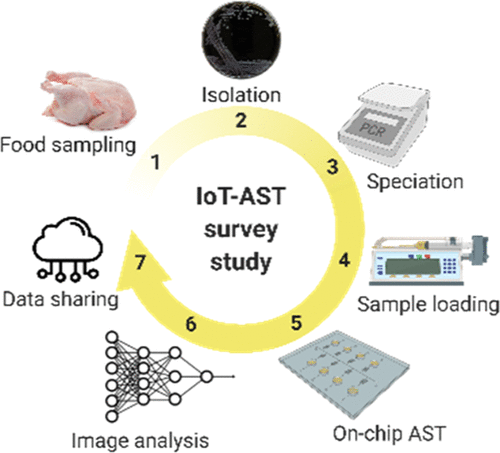Our official English website, www.x-mol.net, welcomes your
feedback! (Note: you will need to create a separate account there.)
Next-Generation Antimicrobial Resistance Surveillance System Based on the Internet-of-Things and Microfluidic Technique
ACS Sensors ( IF 8.2 ) Pub Date : 2021-09-08 , DOI: 10.1021/acssensors.1c01453 Luyao Ma 1, 2 , Weidong He 3 , Marlen Petersen 1 , Keng C Chou 4 , Xiaonan Lu 1, 2
ACS Sensors ( IF 8.2 ) Pub Date : 2021-09-08 , DOI: 10.1021/acssensors.1c01453 Luyao Ma 1, 2 , Weidong He 3 , Marlen Petersen 1 , Keng C Chou 4 , Xiaonan Lu 1, 2
Affiliation

|
Antimicrobial resistance (AMR) of foodborne pathogens is a global crisis in public health and economic growth. A real-time surveillance system is key to track the emergence of AMR bacteria and provides a comprehensive AMR trend from farm to fork. However, current AMR surveillance systems, which integrate results from multiple laboratories using the conventional broth microdilution method, are labor-intensive and time-consuming. To address these challenges, we present the internet of things (IoT), including colorimetric-based microfluidic sensors, a custom-built portable incubator, and machine learning algorithms, to monitor AMR trends in real time. As a top priority microbe that poses risks to human health, Campylobacter was selected as a bacterial model to demonstrate and validate the IoT-assisted AMR surveillance. Image classification with convolution neural network ResNet50 on the colorimetric sensors achieved an accuracy of 99.5% in classifying bacterial growth/inhibition patterns. The IoT was used to carry out a small-scale survey study, identifying eight Campylobacter isolates out of 35 chicken samples. A 96% agreement on Campylobacter AMR profiles was achieved between the results from the IoT and the conventional broth microdilution method. The data collected from the intelligent sensors were transmitted from local computers to a cloud server, facilitating real-time data collection and integration. A web browser was developed to demonstrate the spatial and temporal AMR trends to end-users. This rapid, cost-effective, and portable approach is able to monitor, assess, and mitigate the burden of bacterial AMR in the agri-food chain.
中文翻译:

基于物联网和微流控技术的下一代抗菌药物耐药监测系统
食源性病原体的抗微生物药物耐药性 (AMR) 是公共卫生和经济增长方面的全球危机。实时监测系统是追踪 AMR 细菌出现的关键,并提供从农场到餐桌的全面 AMR 趋势。然而,当前的 AMR 监测系统使用传统的肉汤微量稀释方法整合多个实验室的结果,是劳动密集型和耗时的。为了应对这些挑战,我们推出了物联网 (IoT),包括基于比色的微流体传感器、定制的便携式孵化器和机器学习算法,以实时监控 AMR 趋势。作为对人类健康构成威胁的首要微生物,弯曲杆菌被选为细菌模型以展示和验证物联网辅助的 AMR 监测。在比色传感器上使用卷积神经网络 ResNet50 进行图像分类在分类细菌生长/抑制模式方面达到了 99.5% 的准确率。物联网用于进行一项小规模调查研究,从 35 个鸡样本中识别出 8 个弯曲杆菌分离株。96% 同意弯曲杆菌AMR 曲线是在 IoT 和传统肉汤微量稀释方法的结果之间实现的。智能传感器采集的数据从本地计算机传输到云服务器,便于实时数据采集和集成。开发了一个网络浏览器来向最终用户展示空间和时间 AMR 趋势。这种快速、经济、便携的方法能够监测、评估和减轻农业食品链中细菌 AMR 的负担。
更新日期:2021-09-24
中文翻译:

基于物联网和微流控技术的下一代抗菌药物耐药监测系统
食源性病原体的抗微生物药物耐药性 (AMR) 是公共卫生和经济增长方面的全球危机。实时监测系统是追踪 AMR 细菌出现的关键,并提供从农场到餐桌的全面 AMR 趋势。然而,当前的 AMR 监测系统使用传统的肉汤微量稀释方法整合多个实验室的结果,是劳动密集型和耗时的。为了应对这些挑战,我们推出了物联网 (IoT),包括基于比色的微流体传感器、定制的便携式孵化器和机器学习算法,以实时监控 AMR 趋势。作为对人类健康构成威胁的首要微生物,弯曲杆菌被选为细菌模型以展示和验证物联网辅助的 AMR 监测。在比色传感器上使用卷积神经网络 ResNet50 进行图像分类在分类细菌生长/抑制模式方面达到了 99.5% 的准确率。物联网用于进行一项小规模调查研究,从 35 个鸡样本中识别出 8 个弯曲杆菌分离株。96% 同意弯曲杆菌AMR 曲线是在 IoT 和传统肉汤微量稀释方法的结果之间实现的。智能传感器采集的数据从本地计算机传输到云服务器,便于实时数据采集和集成。开发了一个网络浏览器来向最终用户展示空间和时间 AMR 趋势。这种快速、经济、便携的方法能够监测、评估和减轻农业食品链中细菌 AMR 的负担。











































 京公网安备 11010802027423号
京公网安备 11010802027423号